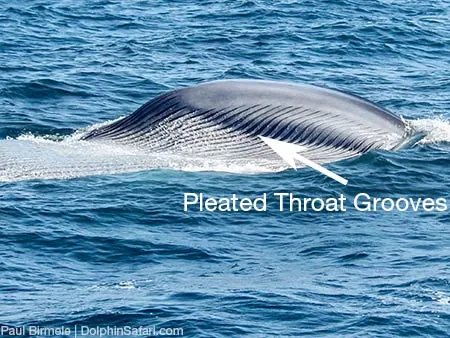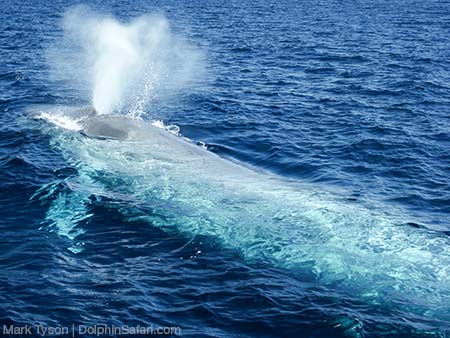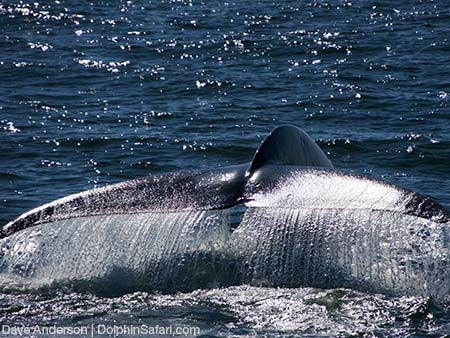Blue Whale Fast Facts
Scientific name: Balaenoptera musculus
Class: Mammalia
Average length: Up to 110 feet
Average weight: Up to 200 tons, about a ton per foot. (400,000 pounds!)
Average lifespan: Estimated at around 80 to 90 years
Current population: The current population of blue whales is about 10,000 to 25,000 animals worldwide. Before whaling, about 300,000 blue whales populated our oceans, 240,000 in the Antarctic alone.
Cruising speed: Blue whales typically cruise the ocean at more than 5 miles an hour but can accelerate to more than 20 miles an hour for short bursts.
Gestation period: Approximately 10 to 12 months
Favorite snack: Krill cakes and tea
Favorite tunes: Blue Man Group
Favorite pastime: Water polo and underwater basket weaving

Blue Whale
Blue Whales: Dive Deeper
So, you want to see a blue whale? Maybe you want to BE a blue whale, meet a blue whale, or give one a high five. Maybe you just simply love blue whales, and want to get to know them a little better? Here at Captain Dave’s we also love blue whales, and we do our best to get to know them a little better too, so we can share them with you!
Read on to discover more about magnificent blue whales.
How big is a blue whale?
The blue whale is, and always has been, the largest animal ever to exist on earth. This whale can grow to a length of 33m (110ft) and weigh 200 tons, about a ton per foot, but on the average, it is much smaller. Meaning these whales measure longer than the Staples Center basketball court and weigh more than 400,000 pounds! Try bench pressing one of these guys, Lebron.

A blue whale’s enormous heart is as big as a VW beetle.

And their arteries are big enough for a baby to crawl through! We can already hear the kiddos begging you to go whale watching this weekend…

What do blue whales eat?
How do they get so large? These bad boys, and girls, feed off of itty bitty crustaceans, better known as krill – a tiny shrimp like animal.
The blue whale is called a “rorqual” a Norwegian word for “furrow” and refers to the pleated grooves running from its chin to navel. The throat grooves, in addition to streamlining the shape of the whale, allow the throat area to expand tremendously (like a balloon) during feeding, and can hold 1,000 tons or more of food and water when fully expanded.

They dine by straining huge volumes of ocean water through their baleen plates (which are like the teeth of a comb), leaving their tummies full of tons of tiny krill. Some of the biggest individuals may eat up to four tons of krill in one day. No wonder we sometimes hear the Blue’s ask, “Honey, does this krill make me look fat?” If it does, we don’t mind! These magnificent blue whales are breathtaking!
What does a blue whale look like?
Blue whales are long, slender, and of course gigantic. Their silver to light blue/gray colored skin with beautiful mottling can appear as brilliant azure under the water.
Blue whales have massive blow holes surrounded by a large splash guard. Their blow holes have a striking resemblance to our own noses, but instead of being placed on their faces, the blow holes rest atop their heads. The sound these beautiful animals make when they surface and exhale is unlike anything you have ever heard.
The sound seems to thunder, then echo, as their breath is released at approximately 200 miles per hour and forced through their blow holes, shooting into the air sometimes as high as 30 feet!

And speaking of the sounds that these animals make, did you know they can talk? Well, sort of… Blue whales are among the loudest animals on the planet, emitting a series of pulses, groans, and moans. And it is thought that in good conditions blue whales can hear each other up to 1,000 miles away. That’s one looooooong distance phone call.
As their body glides through the water, it seems as if it never ends. Then as a bonus, the tail, measuring between 12 and 15 feet wide will sometimes lift into the air, offering a memorable display to onlookers, both near and far. Far FAR as in satellites have spotted these beauties from outer space! Yep, outer space. It that’s not out of this world cool, we don’t know what is.
Here at Captain Dave’s we’re not the only ones who try our best to get an up-close and person encounter with these giants of the sea. Remora fish hitch a ride to feed off the krill that spills from the mouths of blue whales. So, these massive mammals are in fact, not “bad boys and girls,” but are actually quite friendly and generous!

Threats to Blue Whales
Unfortunately, what’s not friendly and generous is the large number of man-made threats posed to these amazing creatures. From inadvertent vessel strikes, ocean noise, pollution, habitat degradation, long-term changes to climate, and what many of us at Captain Dave’s are all too familiar with: entanglement cause by fishing gear, including traps, pots, and gillnets. Once entangled, blue whales may drag and swim with attached gear for long distances, ultimately resulting in fatigue, compromised feeding ability, or severe injury, which may lead to reduced reproductive success and death. Nearly 1,000 dolphins and whales die every day around the world due to fishing gear entanglement. Not cool. Makes ya think twice about eating fish sticks, huh?
Due to their overwhelming size and speed, (they can swim bursts of over 20 miles per hour), the only natural predator of blue whales are orcas (killer whales).
Although their environment poses many different threats, and they are a bit too cozy on the ‘Endangered Species Act’ list, blue whales thrive in the ocean. Their number are increasing globally since they became protected from whales by the international community in 1966. So don’t hold off on that tartar sauce just yet! Blue whales are found in all oceans except the Arctic and generally migrate seasonally between summer feeding grounds and winter breeding grounds. Which brings them to the rich, nutrient filled, warm waters of Dana Point, permeating with abundant groups of their favorite snack: yep, you guess it, krill. This diet has Jonah taking a huge sigh of relief…
When is the best time to see blue whales?
Sorry SeaWorld, there are no aquariums that can hold a gargantuan blue whale! The only place to see them is in the wild. And Dana Point, California, is one of the best places in the world to see blue whales. During the summer months there are more blue whales off our coast than anywhere else in the world.
Blue whale watching in Southern California is typically May through October. Although our eagle-eyed Captains have spotted blue whales as early as February and as late as November. So if you’re feeling blue, or craving an encounter with THE largest animal on this planet, then come aboard! Join us on one of our daily whale watching safaris where we’ll sport our remora selves and get you as up-close and personal with these azure-colored giants as possible. You won’t regret it, and you definitely won’t forget it!
P.S. While aboard your whale watching safari, don’t challenge one of these pals to a breath holding contest. You may pass out before your blue whale friend begins its dive down into the deep blue, holding its breath for up to 35 minutes! That’s longer than your favorite television episode on Netflix. Celine’s pipes are nothing in comparison to the set of lungs in the beautiful whales.
